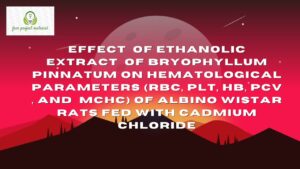ABSTRACTS
This study was conducted to investigate the nutritional composition of poultry comb (Proximate compositions and minerals). Minerals analysis was done using standard procedure while and the concentrations of Ca, Na, K, Mg, P, Zn, Fe, Cu, Mn, and Co were determined using atomic absorption spectrophotometry (AAS). The mean levels of the minerals in mg/100g were ranged as:110.25±0.21 for Ca; 56.92±0.19 for Na; 49.02±0.51 for K; 30.75±0.09 for Mg, 10.10±0.02 for P; 7.15 ±0.17 for Zn; 4.91±0.015 for Fe; 9.65±0.08 for Cu; 6.24±0.71 for Mn; and 2.54±0.06 for Co. Also, the mean levels of the proximate compositions were ranged 34.34±0.12% for moisture contents; 10.33±0.106% for ash content; 1.32±0.099 for crude fibre; 19.08±1.06% for crude lipid; 20.76±0.085% for crude protein; 48.760.064% for carbohydrate; and 449.08±0.113% for caloric value. Therefore, it can be concluded that poultry comb contain minerals and higher proximate composition that can boast the nutritional status of an individual.
TABLE OF CONTENTS
TITLE PAGE – – – – – – – – i
CERTIFICATION – – – – – – – ii
DEDICATION – – – – – – – – iii
ACKNOWLEDGEMENTS
ABSTRACT – – – – – – – – vi
TABLE OF CONTENTS – – – – – – vi
CHAPTER ONE : INTRODUCTION – – – – 1
1.1 Background of the study
1.2 Aim and Objectives of the Study – – – – – 3
1.2.1 Aim – – – – – – – – – 3
1.2.2 Objectives – – – – – – – – 4
1.3 Scope and Limitation of the Study – – – – 4
1.4 Significance of the Study – – – – – – 4
1.5 Definition of Related Terms – – – – – 4
CHAPTER TWO: LITERATURE REVIEW
2.1 The Chicken – – – – – – – – 6
2.2 Taxonomy (Classification) of Chicken – – – – 8
2.3 Chicken Parts and their Uses – – – – – 9
2.3.1 The by-Product of Chicken – – – – – 12
2.4 The Use of Chicken in Farming – – – – – 13
2.4.1 Reared for Meat – – – – – – – 13
2.4.1 Reared for Eggs – – – – – – – 14
2.4.3 The use of Chicken as Pets – – – – – 14
2.5 The Chicken comb/Shape – – – – – 15
2.6 Uses of Chicken Comb – – – – – – 17
2.7 Nutritional Value of Chicken Comb – – – – 19
2.8 Proximate Composition – – – – – 20
2.8.1 Ash Content – – – – – – – 20
2.8.2 Moisture Content – – – – – – 21
2.8.3 Crude Protein – – – – – – – 21
2.8.4 Crude Fiber – – – – – – – 23
2.8.5 Crude Lipid – – – – – – – 24
2.8.6 Carbohydrate – – – – – – – 25
2.9 Minerals – – – – – – – – 26
2.10 Biochemical/Biological Importance of some Minerals – – 28
CHAPTER THREE: MATERIALS AND METHOD
3.1 Material and Reagents – – – – – – 32
3.2 Methods – – – – – – – – 33
3.2.1 Sample Collection – – – – – – 33
3.2.2 Sample Preparation – – – – – – 34
3.2.3 Digestion of the Sample for Mineral Analysis – – 34
3.3 Determination Proximate Composition – – – 35
3.3.1 Determination of Moisture Content – – – – 35
3.3.2 Determination of Ash Content – – – – 35
3.3.3 Determination of Crude Lipid using Soxhlet Method – 36
3.3.4 Determination of Crude Fibre – – – – – 37
3.3.5 Determination of Crude Protein – – – – 37
3.3.6 Determination of Carbohydrate – – – – 39
3.3.7 Determination of the Caloric Value – – – – 39
3.4 Determination of Minerals – – – – – 40
3.4.1Determination of Sodium and Potassium by
Atomic Absorption Spectrophotometry(AAS) – – 40
3.4.2 Determination of Potassium – – – – – 40
3.4.3 Determination of Phosphorus: Molybodovanadate Method – 41
3.4.4 Determination of Magnesium – – – – – 41
3.4.5 Determination of Calcium – – – – – 42
CHAPTER FOUR: RESULTS AND DISCUSSION
4.1 Results – – – – – – – – – 43
4.2 Discussion – – – – – – – – 45
CHAPTER FIVE: CONCLUSION AND RECOMMENDATIONS
5.1 Conclusion – – – – – – – 49
5.2 Recommendations – 49
5.3 Suggestion for further studies – – – – – 50
References
CHAPTER ONE:
1.1 INTRODUCTION
The Comb is an ornamental organ in chicken which can be used as an indicator of health and sexual maturity.
The Comb is a highly vascularized organ consisting of a network of arteries, veins, capillary blood vessels and an intricate network of sinus capillaries and arterioles making up a micro- circulation system similar to systems in the heart and brain of humans (Hodges, 1974 and Yoshuka et al., 2016), the main blood supply to the comb is supplied by an artery located at the skull directly under the comb. The artery also supplies blood to the masseter muscle, which controls the opening and closing the jaw while also supplying blood flow to then eye lids and tongue (Brown, 2018).
Most domestic chickens are highly sexually dimorphic with the male processing a red fleshy comb and wattle as well as bright plumage. While is relatively drab the scientific name for the chickens Gallus domesticus. Bálint et al., (2011) reflects the importance of combs in the world today can be traced back only to two types of genes. Pea comb and rose comb genes. The poultry association recognizes nine different kinds of combs, pea, rose, single, carnation or king’s, buttercup, cushion, strawberry, silkie and walnut (Anderson 2011).
A healthy comb is generally an indicator of health status, disease resistance and nutritional status of the fowl (Zuk et al., 1990 and Johnson et al., 1993).
The Chicken is used for second selection in all types of condition and is an important secondary sexual characteristic which indicates the bird’s hormone status. A healthy comb indicates a male and a less developed comb indicates a female. In chicken, comb type is the result of genes interacts but comb size is associated with gonadal development (North and bell, 1990). As a result, a longer redder comb is red jungle fowl cockerels are chosen preferentially by hens (Zuk et al., 1995, Johnsen and Zuk, 1996). There are several fleshy protuberances on the heads and throats of gallinaceous birds, i.e., the comb, wattle and ear lobe, which are collectively called carbuncles (Dave, 2008).
Chicken combs are most commonly red (but may be black or dark purple in breeds such as silkies or sebrights), but in other species the color may vary from light grey to deep blue to red. It is primarily for display but it also serves to cool the bird in hot weather (Evans, 1993). The Comb has medicinal value and is harvested from chickens to be used to supplement meniscus cartilage tissue in the knee joints of humans. In addition to joints, hyaluronic acid is also found in human skins, where it helps keep it moist and elastic (Brown, 2018).
1.2 Aim and Objectives of the study.
1.2.1 Aim:
The aim of this research work is to investigate the nutritional composition of poultry comb (Proximate composition and minerals).
1.2.2 Objectives:
The Objectives of the Study are:
- To investigate the proximate composition of poultry comb
- To determine the minerals (Sodium, potassium, magnesium, iron and calcium)
- To discuss the significance of the
- To make relevant suggestions/recommendation.
1.3 Scope and Limitation of the Study
This research project was designed to investigate the nutritional composition of poultry comb with special emphasis on (proximate composition and minerals). Both time constraint and peer finances limited the scope of this research work.
1.4 Significance of the Study
This research is significance because it will add value to information on nutritional value of domestic fowl comb and will contribute to existing literature on domestic fowl.
1.5 Definition of Related Terms
Domestication: The process of taming an animal and keeping it as a pet or on a farm.
Poultry: Poultry are domesticated avian species that can be raised for eggs, meats and lor feathers.
Comb: A comb is the red fleshy crest on the head of a domestic fowl, especially a cock.
Wattles: (In chicken meaning) wattles are fleshy flaps of skin that hang either side of young
Hen’s throat starting just behind the beak.
Nutritional Composition: Is the information about food composition that necessary for the assessment of diet quality and the development and application of food-based dietary guidelines.
Minerals: Minerals are chemical elements required as an essential nutrient by organisms to perform function necessary for life.
Proximate Composition: Proximate Composition is used in analysis of biological material, such as the decomposition of human consumable goods into major constituents.



